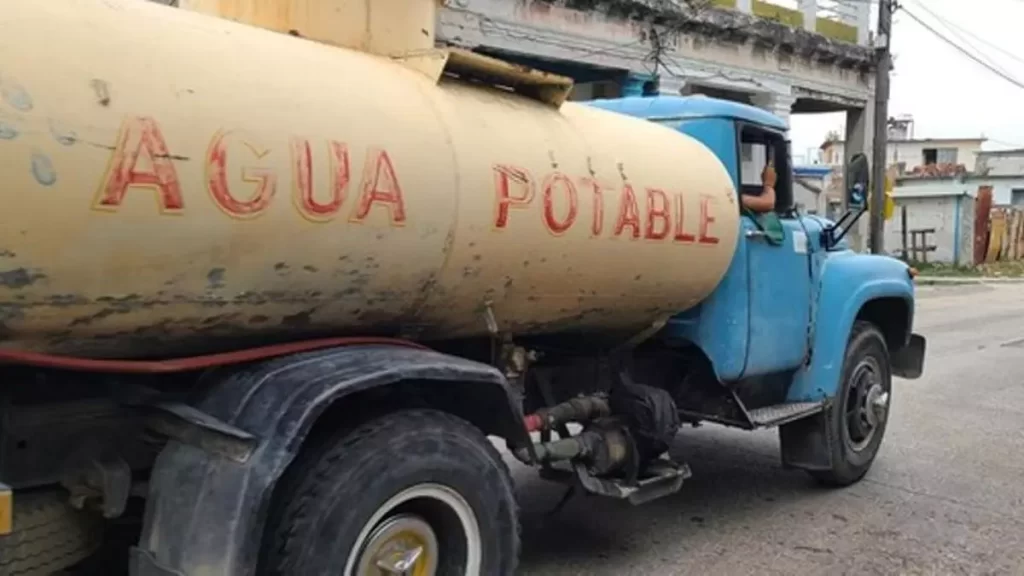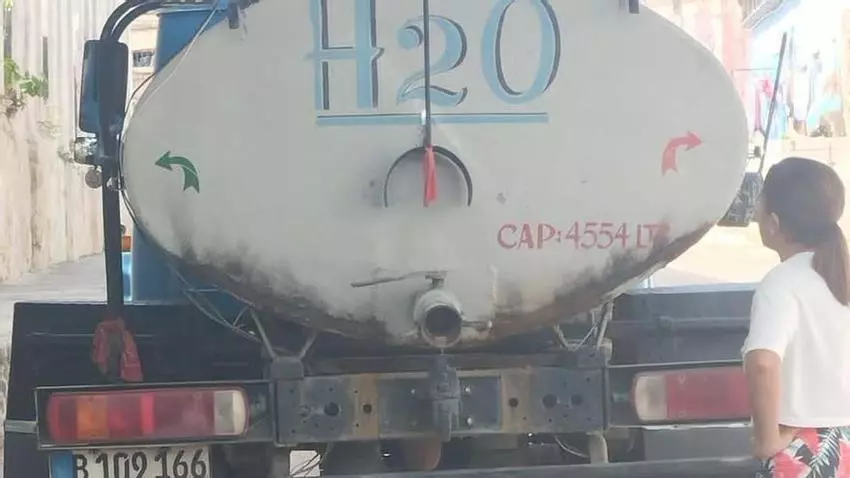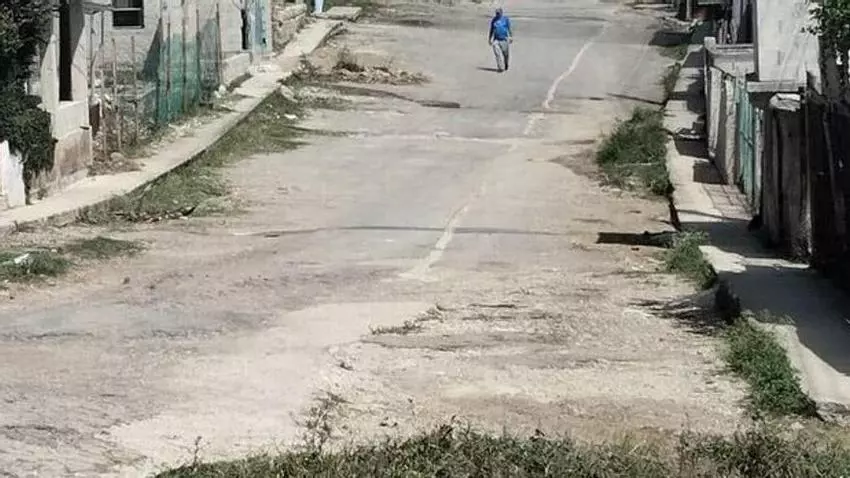
![]() 14ymedio, Pedro Espinosa, Havana, 31 March 2024 — Without changing his tone of voice, an official of the government of Havana explained this Thursday to Joaquín, a 68-year-old retiree, why the neighborhood of Santa Fe, in Guanabacoa, had not received water for more than ten days. “The reservoirs are dry,” he said before hanging up the phone. With that data – and trying not to lose his temper – the old man went to the Communist Party, the municipal delegate and the leaders of his area. He received more laziness and a piece of advice: “Don’t go anywhere else.”
14ymedio, Pedro Espinosa, Havana, 31 March 2024 — Without changing his tone of voice, an official of the government of Havana explained this Thursday to Joaquín, a 68-year-old retiree, why the neighborhood of Santa Fe, in Guanabacoa, had not received water for more than ten days. “The reservoirs are dry,” he said before hanging up the phone. With that data – and trying not to lose his temper – the old man went to the Communist Party, the municipal delegate and the leaders of his area. He received more laziness and a piece of advice: “Don’t go anywhere else.”
A “comrade” of the Communist Party at least was sincere, Joaquín tells 14ymedio. “I’m a militant but I’m not going to deceive you,” she confessed. “What am I going to tell you? One more lie? This has no solution. It’s disrespectful, because even if the reservoirs are dry, they should send pipas.”

The dry streets of Santa Fe, the discomfort of his family and the economic desperation in the face of the economic crisis of the Island have caused, as Joaquín defines it, the problems of the neighborhood to be “a chain.” The leaders, he believes, are mere “smoke-screens,” whose function is to kick the ball down the road and dodge anyone who asks for explanations. “That’s how they stay clean themselves,” he says, alluding to the Government and pointing his finger at the ceiling.
The restoration of the service – after Joaquín called Havana – was short-lived: “First thing in the morning this Friday they had already removed it,” he says. Another palliative measure – this Wednesday – was to send a pipa, but without a hose. In front of the impoverished Hino truck, rusty and decorated with a red ribbon “against the evil eye,” the neighbors gathered in a show that Joaquín found regrettable.
“Old men carrying water, one pipa for the whole block… it’s abusive,” he says. “People are drinking water even from puddles. They are not bathing because not everyone has a cistern. But, today, who can build a cistern? One bag of cement costs 4,000 pesos on the street and 7,000 privately, and the aggregate costs 3,500.”
It doesn’t seem bad to him that, whoever can, pays for a private pipa. What he does not conceive is that the poor people of Santa Fe, who have been complaining about the difficulties in the supply for years, are sent a pipa by the authorities like this Wednesday’s. “If you’re going to send a pipa to a place where people have tanks upstairs – on the roofs – how are you going to send them one without a hose?” he asks.

Gloria, a 47-year-old housewife, can no longer be silent on the subject. Squeezed by the shortage, she has personally demanded a solution from the local Aqueduct officials. “There are children here,” is the first thing she says, “and they have been without water for 18 days.” The director’s response was that they didn’t turn on the turbines because the water “is dirty.”
“They have very old turbines,” Gloria explains to this newspaper. “My proposal is that they put on the water one day yes and one day no. Yesterday they put it on for a moment. They have already turned it off. And the tremendous amount of clothes that many mothers were washing, for example? They don’t send pipas or anything. The delegate does not give answers. He says he doesn’t plan to complain because it doesn’t do any good.”
Others, for fear of possible reprisals or because they don’t believe that local leaders can solve anything, prefer to resign themselves. This is the case of Sandra, age 25, who knows that the neighbors of Santa Fe have tried to expose the situation, although she, “personally”, has not done anything. “It’s a critical situation,” she admits, to which blackouts and shortages are added. “But the problem of water is what affects us the most, not so much electricity. But hey,” she says shrugging her shoulders, “there are worse places.”
“Whoever can invent, invents,” is the motto of Jorge, a 32-year-old mechanic. But the saying has a coda: “He who can’t invent gets on board.” They are the most in Santa Fe. Luckily, he says, his house is on a kind of “border”: “Going up it’s worse,” he says, pointing to a group of houses where the water does not reach because “it has no strength.” When a pipa arrives, they are the ones that carry the most water buckets.
“But, today, who can build a cistern? The cement bag is at 4,000 pesos on the street and 7,000 in a private company, and the aggregate costs 3,500”
Like many of the streets of Guanabacoa, those of Santa Fe are full of potholes. The drought is noticed even by the children, who play at spinning tops near Jorge’s house. One of them unrolls the string and throws the toy on the asphalt, which leaves a wake of dust as it “dances.”
In the living room of his house, Pedro – retired at age 75 – watches the midday news. He likes to see “the part on Ukraine,” but when the national newscasters come on and announce the sending of “so many water pumps” he loses his patience. “Where are all those teams and why don’t any of those pumps get to Santa Fe? They start saying that they are going to give pumps to everyone because there is a lot of breakage. And what about us?” he asks.
From the kitchen, his daughter explains what she has been told: “There is a problem because a pump was blocked and the water is cloudy.” Disillusioned, Pedro returns to his problems: “I don’t know,” he says, “I’m tired of scratching and not being able to bathe.”
The reservoirs, the pumps, the filter, the dirt, the fuel, the broken equipment… the residents of Santa Fe no longer know what to believe. In the mouths of leaders whom no one trusts, multiple causes are attributed to the same phenomenon. In the hard way, families have learned that leaders only react when the same vessels they use to conserve water resonate during a cacerolazo*, going out into the street and banging on pots and pans.
*Translator’s note: Cacerolazo [from ’cacerola’ – saucepan — and the source of ’casserole’’ in English] is the word for beating on pots and pans, a common form of protest in much of Latin America.
Translated by Regina Anavy
____________
COLLABORATE WITH OUR WORK: The 14ymedio team is committed to practicing serious journalism that reflects Cuba’s reality in all its depth. Thank you for joining us on this long journey. We invite you to continue supporting us by becoming a member of 14ymedio now. Together we can continue transforming journalism in Cuba.
